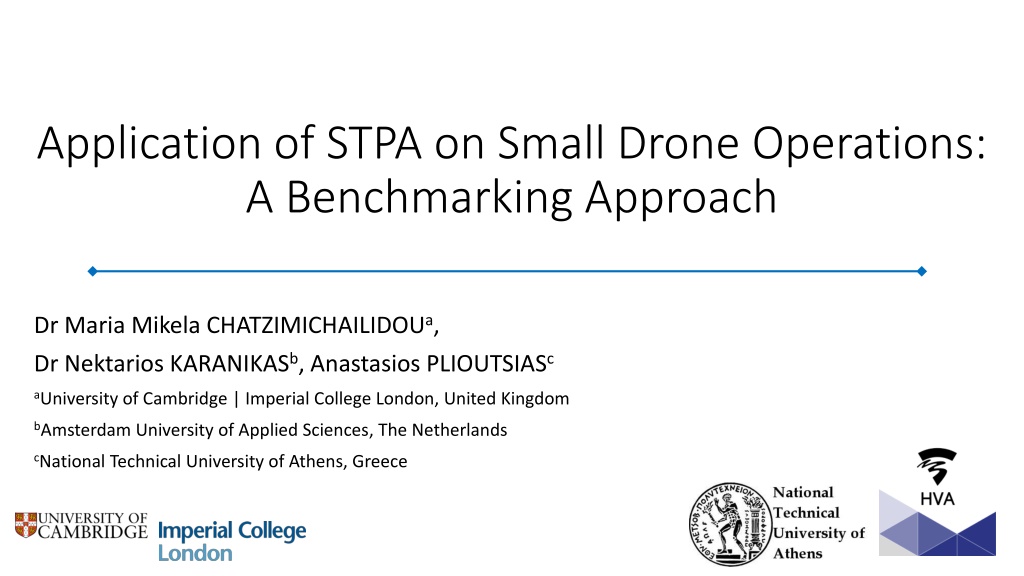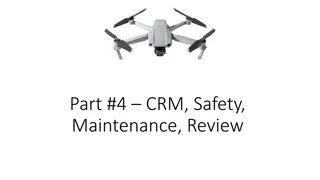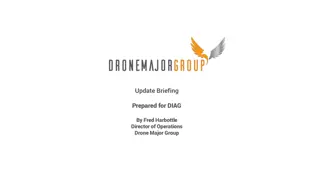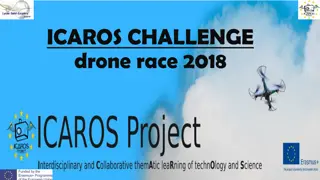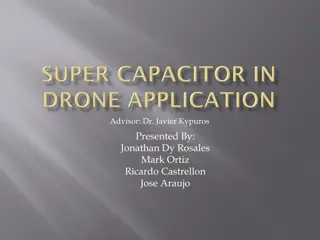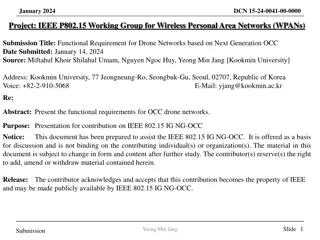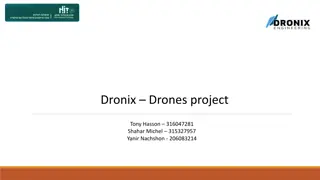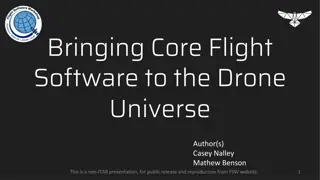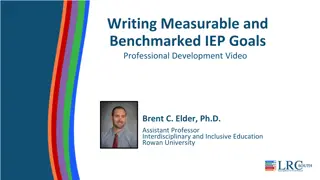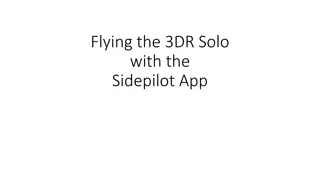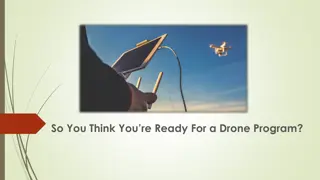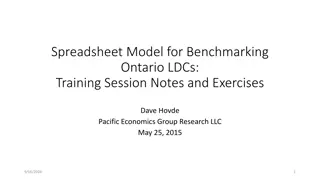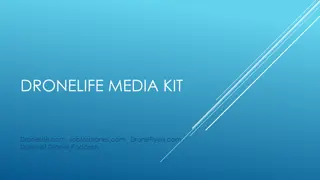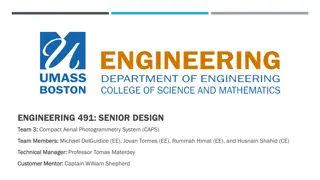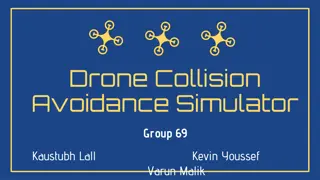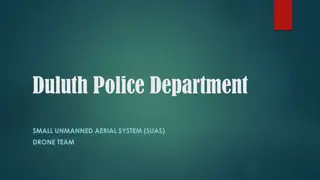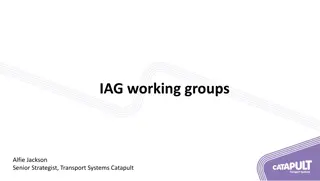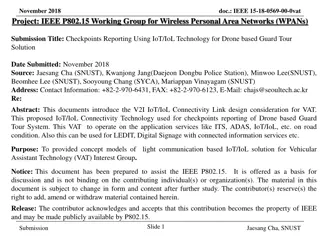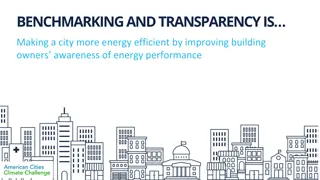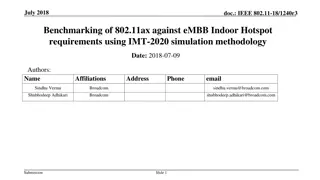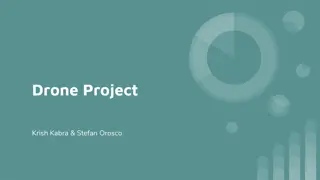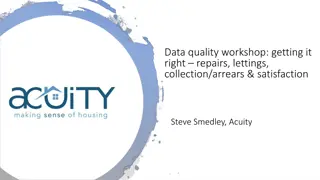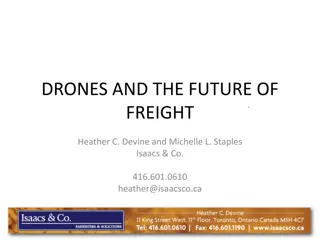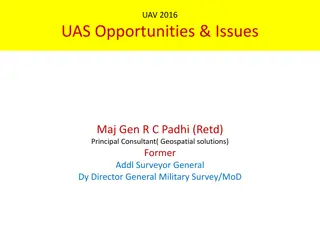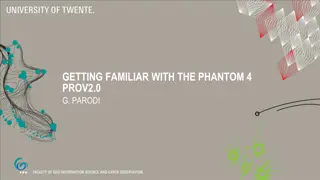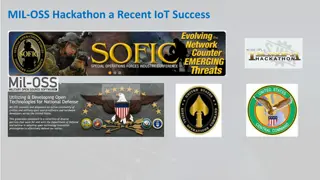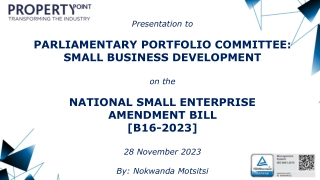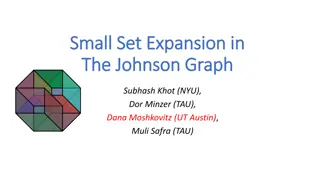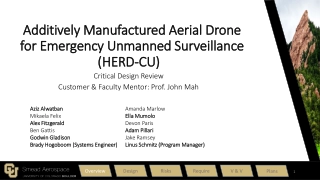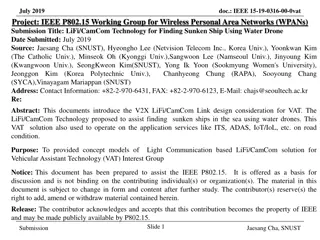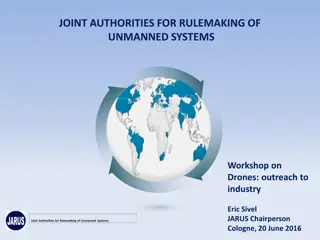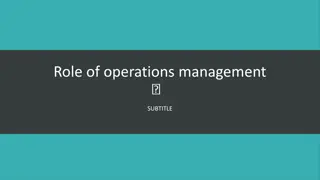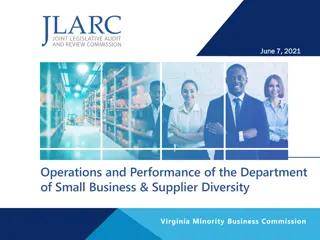Application of STPA on Small Drone Operations: A Benchmarking Approach
This study focuses on the application of the System Theoretic Process Analysis (STPA) methodology to identify hazards and safety requirements for small drone operations. It addresses the lack of a uniform regulatory framework for unmanned aircraft systems, especially for light drones, and explores the complexities of drone flights. The research framework includes risk analysis studies and proposes a user-centric approach to enhance safety in small drone operations.
Download Presentation

Please find below an Image/Link to download the presentation.
The content on the website is provided AS IS for your information and personal use only. It may not be sold, licensed, or shared on other websites without obtaining consent from the author. Download presentation by click this link. If you encounter any issues during the download, it is possible that the publisher has removed the file from their server.
E N D
Presentation Transcript
Application of STPA on Small Drone Operations: A Benchmarking Approach Dr Maria Mikela CHATZIMICHAILIDOUa, Dr Nektarios KARANIKASb, Anastasios PLIOUTSIASc aUniversity of Cambridge | Imperial College London, United Kingdom bAmsterdam University of Applied Sciences, The Netherlands cNational Technical University of Athens, Greece
Outline 1. Literature review 2. Current situation 5. Proposed methodology 3. Research framework 6. Results 4. Assumptions 7. Final remarks Mikela CHATZIMICHAILIDOU ESW |September 2016
EASA, 2016: Drone Occurrences 400 occurrences in 2015 4.5 times higher than in 2014 Moreover.. clear & universally accepted Unmanned Aircraft Systems (UAS) regulatory framework not yet in place UASs currently operated under different regulations depending on the country they are flown Mikela CHATZIMICHAILIDOU ESW |September 2016
Risk Analysis studies so far.. 2015, Clothier et al.: Risk management framework FMEA, HAZOP 2008, Loh et al.: Suggestions to developers Safety certification for operation 2015, FAA: Operation and Certification of Small UAS similar to manned aircraft; airman certification 2011, Dalamagkidis et al.: Reliability assessment FMEA, FTA; particular models 2002, ACASA: Rules for unmanned aerial activities pilot qualifications, risk management, airworthiness 2005, Kuchar: Methods for ensuring collision avoidance FTA, Dynamic Simulation 2013, Lee et al.: Probabilistic safety assessment collision rates in high-traffic activity 2015, EASA: Technical Opinion 27 suggestions; low-risk operations irrespectively of take-off mass 2008, Johnson: Contribution of human factors to heavy military UAS loss Events and Causal Factors accident analysis Mikela CHATZIMICHAILIDOU ESW |September 2016
Current Situation 1. No uniform regulatory framework for UASs; especially for light drones 2. Linear approaches grounded on reductionism; without adequately addressing the complexity of drone flights; no reliable (failure) data 3. End-user centric approach: publication of directives & regulations focusing heavily on drone operators several authorities (e.g., CAA; FAA; ACASA) not addressed requirements for small drone design & certification nor their own responsibilities Mikela CHATZIMICHAILIDOU ESW |September 2016
Research Framework STPA-based approach to identify hazards & safety requirements (SRs) for small-drone operations Analysis of a typical operator drone system with STPA: list of hazards & causal factors to unwanted events STPA SRs assigned to authority, manufacturer, operator & automation 4 highly marketed models compared against STPA SRs [Case A] 4 models compared to each other [Case B] RiskSOAP* methodology: a means of quantification with the Rogers- Tanimoto dissimilarity measure * Chatzimichailidou, M. M., & Dokas, I. M. (2015). Introducing RiskSOAP to communicate the distributed situation awareness of a system about safety issues: an application to a robotic system. Ergonomics, 1-14. Mikela CHATZIMICHAILIDOU ESW |September 2016
Assumptions <25Kg in US & <30Kg in EU Drone system components: remote controller, drone & display (telemetry) Rotary aircraft = not subject to aerodynamic limitations Mission losses in terms of safety Collisions with fauna not considered Depth of analysis: end-user drone; higher hierarchical levels implications further decomposition (e.g., architecture and links of software and hardware subsystems) out of scope Mikela CHATZIMICHAILIDOU ESW |September 2016
Proposed Methodology [4 Stages-7 Steps] [Stage 1] Define STPA benchmarking system for small-drone flights [Stage 2] Map original elements (i.e., SRs met by each drone) to benchmarking system [Stage 3] Employ a dis.measure for binary data to depict the distance between ideal & real system [Stage 4] Use a dis.measure to calculate the differences amongst drones pairwise Mikela CHATZIMICHAILIDOU ESW |September 2016
High-level hierarchical control structure Mikela CHATZIMICHAILIDOU ESW |September 2016
Results Results (cont.) cont.) Preliminary STPA Steps Mikela CHATZIMICHAILIDOU ESW |September 2016
Safety Control Structure Mikela CHATZIMICHAILIDOU ESW |September 2016
Screenshot of binary data 66 SRs Mikela CHATZIMICHAILIDOU ESW |September 2016
RT[Case A] Ideal STPA M[1] M[4] M[2] M[3] Mikela CHATZIMICHAILIDOU ESW |September 2016
RT[Case B] M[1] M[2] M[3] M[4] M[1] M[2] M[3] M[4] [M2] & [M3] safety controls through automation [M1] relies on human & meets the least SR [M2] & [M3] same manufacturer Mikela CHATZIMICHAILIDOU ESW |September 2016
Summing up (cont.) Comprehensive analysis to measure dissimilarities Case A: benchmark/ STPA existing/ real drone system Case B: exiting/ real done systems, with identified gaps in their SRs (user manuals) Proposed approach; RiskSOAP adaptation Dissimilarity measure other than Rogers-Tanimoto 4 drone models: approach demonstration & safety conclusions with RiskSOAP Rogers-Tanimoto STPA SRs coverage at low to moderate level high dissimilarities in meeting the same SRs Mikela CHATZIMICHAILIDOU ESW |September 2016
Summing up STECA (Systems-Theoretic Early Concept Analysis) concept analysis: [conceptualisation, system requirements] narrative/ textual description of the system under development Proposed approach later in life-cycle: system already designed & operated; modifications possible user manuals & design specifications available; 4 drone models already built scs of generic small-drone system drawn after reading several user manuals & regulations explaining how it works Mikela CHATZIMICHAILIDOU ESW |September 2016
Conclusions (cont.) Regulatory framework for small drones diverse & focuses on limitations that the user needs to consider Published UAS risk analysis (RA) based on manned aircraft; not on HA for small drones operated in uncontrolled airspaces UAS safety research based on statistical analyses & specific accident scenarios or UAS models structured HA behind those studies? Missing regulatory framework grounded on systematic & transparent safety analysis Mikela CHATZIMICHAILIDOU ESW |September 2016
Conclusions Starting point to move towards the development of a holistic & methodologically justified standardisation scheme for small-drone flights Proposed approach evaluate embedded safety & improve it across existing drone systems over time high-level gap analysis between drone specifications & the ideal (i.e., STPA) system [Case A] indicate whether drone models offer the same controls over safety constraints [Case B] Mikela CHATZIMICHAILIDOU ESW |September 2016
Future Work RiskSOAP in full: EWaSAP; define sensor characteristics & embed appropriate sensors to enhance threats & vulnerabilities awareness Improvements in sensor technology no increase in weight, no overwhelming feedback to end-user, no confusion in prioritising safety controls 19-drone sample (sub. Risk Analysis) broader results from comparative analysis common & holistic risk management framework for small drones Dissimilarity analysis for Authority regulations (sub. ICSC2016) extent of diversity of current rules & standards Mikela CHATZIMICHAILIDOU ESW |September 2016
Acknowledgements The authors would like to thank Dr Ioannis Dokas for his idea to apply an adaptation of RiskSOAP in order to indicate the differences amongst the compared drone models in a quantitative manner. The authors are also grateful to the two peer-reviewers for their valuable comments and suggestions that helped strengthen the logic of the manuscript. Mikela CHATZIMICHAILIDOU ESW |September 2016
Thank you! Contact: mmc60@cam.ac.uk mikelachatzimichailidou@gmail.com ResearchGate, LinkedIn, Twitter, FB
